Marwell Zoo
Marwell Zoo is a 140-acre (57 ha) zoo situated in Colden Common near Winchester, in the English county of Hampshire. It is owned and run by the registered charity Marwell Wildlife. The zoo is home to 1,208 animals of 149 species. The charity undertakes a range of educational and conservation activities, with a particular focus on Africa in addition to work from its base.
 | |
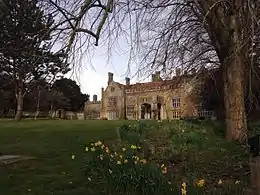 Marwell Hall, March 2016 | |
| Date opened | 1972 |
|---|---|
| Location | Owslebury, Hampshire, England, United Kingdom |
| Coordinates | 50°59′35.39″N 1°16′39.85″W |
| Land area | 140 acres (57 ha) |
| No. of animals | 1208+ (2019) |
| No. of species | 149 (2019) |
| Annual visitors | 511,000 (2006)[1] |
| Memberships | BIAZA,[2] EAZA,[3] WAZA,[4] IUCN[5] |
| Major exhibits | Roof of the World, Into Africa, Heart of Africa, Life in the Trees, Wild Explorers, African Valley, Fur-Feathers-Scales, Energy For Life: Tropical House, Aridlands |
| Website | http://www.marwell.org.uk |
History
The zoo was founded by Dr John Knowles, opening in 1972. He sold a Rolls Royce of his to buy some zebras. It was one of the earliest zoos in Europe to place an emphasis on animal conservation.[6] Within a few years of its establishment, it became an important breeding centre for several species, some (e.g. the Mongolian wild horse) already extinct in the wild, others (e.g. the snow leopard and Siberian tiger) close to extinction.[7]
The park is situated in the estate of Marwell Hall, a Grade I listed building originally built around the year 1320 by Walter Woodlock[8] and largely rebuilt in 1816 by William Long.[9] In the 1500s, the Hall belonged to the Seymour family, and there is a local legend that Henry VIII married Jane Seymour there.[10] Between September 1941 and March 1944, Cunliffe-Owen Aircraft used the area (part of the managing director's personal estate) as an airfield to support the manufacture of military aircraft at its nearby factory in Eastleigh. After the end of World War II, the area was returned to agricultural use until the establishment of the zoo.[11][12]
In 1977, a giraffe called Victor tore a muscle in his leg, collapsed on his stomach, and was unable to get up. The press suggested that he had slipped while trying to mate and compared his situation to the splits.[13] All attempts to get him on his feet failed, and his plight became a major international news story. Portsmouth Dockyard made a hoist to attempt to raise him onto his feet. He died of a heart attack very shortly afterward in the arms of his keeper Ruth.[14] The publicity turned Marwell into a major tourist attraction, and interest was revived the following summer, when Victor's mate, Dribbles, gave birth to a female calf named Victoria.
In 1991 Dr John Knowles was awarded an OBE for services to conservation.
In 1999, the zoo lost all of its penguins (22 African and 5 macaroni) to avian malaria.[15] There were other cases in the UK but Marwell was the only zoo to lose its entire colony, which had arrived only two and a half years before to stock the new Penguin World exhibit. After consulting with experts, the exhibit was restocked with Humboldt penguins, which whilst endangered in the wild, are present in greater numbers in captivity.
In 2003, after constructing a new enclosure for critically endangered Amur leopards, a female leopard (Jade) escaped and fell from a tree to her death after being shot with a tranquiliser dart[16] only days before the official opening of the exhibit. Following a replacement after the death of Jade, in 2005 the first cub born to the new Amur leopard pair, Amirah, escaped into the male's enclosure and was killed by her father.[16] On 18 November 2007, a female Amur leopard cub (named Kiska following a public vote) was born as a result of a European Conservation Breeding Programme.
Both the park and charity changed their name to "Marwell Wildlife" in April 2009,[17] to promote awareness of conservation work beyond the park. The charity had previously been called the Marwell Preservation Trust, and the park had been Marwell Zoological Park.
Animal exhibits
The park includes a number of themed areas, including:
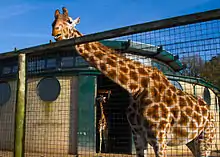
- Roof of the World is themed along the Himalayan mountain range and exhibits snow leopards Indeever and Irena and a Northern White-faced Owl in natural surroundings
- World of Lemurs - a glass corridor around the lemur enclosures exhibiting: black and white ruffed lemur, Red Ruffed Lemur, Alaotran gentle lemur and ring tailed lemur as well as various small monkey species such as Guianan Squirrel Monkey, Golden Lion Tamarin, Golden-headed Lion Tamarin, White-faced Saki and Silvery Marmoset which only recently have been joined by a pair of Bokiboky (Narrow-striped Mongoose). In addition to this there is a large stream running around the back of the enclosures which is home to Goldfish, Tinfoil Barb, Pacu, Granulated Catfish, Marbled Catfish, Ripsaw Catfish, Common Carp, Plecostomus and Grass Carp.
- Lemur Loop is a walkthrough exhibit home to three different species of lemur. It opened in 2017 and allows guests to get up close to these playful primates. Black-and-white ruffed lemurs (Varecia variegata), a crowned lemur (Eulemur coronatus) and ring-tailed lemurs (Lemur catta) are joined in the exhibit by a green peafowl (Pavo cristatus).
- Penguin Cove was refurbished in 2012 and is home to 15 Humboldt penguins[18]
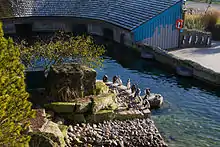
- Aridlands & Desert Carnivores is home to addax, dorcas gazelles and curly-tailed lizard.
- Fur, Feathers & Scales was renamed in 2015 and currently includes a walk-through aviary for African birds (including Hamerkop, Waldrapp Ibis, Village Weaver, Mount Omei Liocichla and Madagascar Teal), Cold Blooded Corner, a reptile house housing rare species' such as Gila monster and Madagascan tree boa, a partula snail unit, Egyptian tortoises and sun conure aviaries. 2019 also saw the redevelopment of an enclosure for the red panda's.
- Australian Bush Walk consists of two walk-through areas. The first part is home to Bennett's wallabies, and the second is an aviary home to a Hamerkop and Pied Imperial Pigeon. The aviary's former residents, a pair of Wrinkled Hornbills, died of a bacterial infection in February 2020.
- Life in the Trees is modelled on an Indonesian rainforest and featuring a traditional long boat house as the centrepiece. This exhibit is home to siamangs, anoa and Asian small-clawed otters.
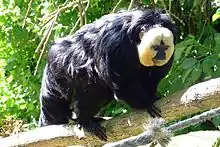
- The Valley Field features Hartmann's Mountain Zebra roaming enclosed in 25 acres (0.10 km2) of land centred on a waterhole.
- Wild Explorers Opened in July 2015, at a cost of £3.6m, this exhibit focuses on the natural history and conservation of southern white rhino, Common Ostrich, Grevy's zebra and scimitar-horned oryx.[19]
- Formal Garden was opened in July 2010, and includes a knot garden, parterre garden and a kitchen garden as well as a self-guided 'tree trail' This loops round to the back lawn which includes enclosures for Cotton-topped Tamarin and Blue-crowned Laughing Thrush.
- Energy For Life: Tropical House opened in February 2018. This innovative and sustainable exhibit spans two levels with fantastic vantage points. Guests can experience face-to-face encounters with a diversity of wildlife, including a Linne's two-toed sloth, various free-flying birds (such as Asian Glossy Starling, Sclater's Crowned Pigeon, Superb Fruit Dove, Nicobar Pigeon, Crested Wood Partridge and Brazilian Tanager), beetles (sun and flower), tropical fish, an iguana, a monitor lizard and mouse deer and exotic plants in a tropical climate, while learning about the flow of energy through life.
Animals
The zoo's exhibits[20] include (in addition to those mentioned above in the Animal Exhibits section):
- 219 mammals of 59 species; including tamarins, meerkats, leopards, Amur tigers and Sudan cheetahs.
- 181 birds of 37 species; including rheas, ibis and flamingoes
- More than 50 reptiles of 17 species; tortoises.
- More than 11 amphibians of 3 species; including poison dart frogs
- More than 26 fish of 19 species.
- More than 720 invertebrates of 14 species; including leaf cutter ants.
In particular, Marwell houses a large collection of ungulates, including:
- Scimitar-horned oryx
- Arabian oryx
- Addax
- Roan antelope
- Sable antelope
- Lesser kudu
- Nyala
- Dorcas gazelle
- Sitatunga
- Eastern bongo
- African forest buffalo
- Lowland anoa
- Grevy's zebra
- Hartmann's mountain zebra
- Przewalski's horse
- Somali wild ass
- Southern white rhino
- Lowland tapir
- Rothschild giraffe
- Okapi
- Collared peccary
- Warthog
- Pygmy hippopotamus
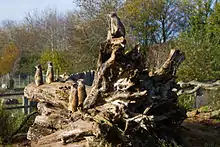
Conservation
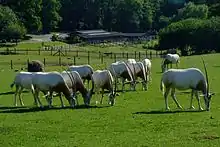
The main, current Marwell Wildlife conservation programmes include Managing Biodiversity in Hampshire, assisting Grevy's zebra and its ecosystem in Kenya; supporting threatened species in Zimbabwe and managing the population of small, vulnerable populations; and reintroducing the scimitar-horned oryx to the Sahara.[21]
The zoo has been involved in reintroducing wild horse, golden lion tamarin, roan antelope and scimitar oryx to the wild. The oryx was extinct in the wild, but more than 200 calves have been born and reared at the zoo since 1972 and many of these have been released back to the Sahara with animals from Whipsnade Zoo and Edinburgh Zoo.
The charity carries out a range of research and education activities and provides the office for the IUCN antelope specialist group.
Marwell Zoo has had notable success breeding various endangered animals including: black and white ruffed lemur (critically endangered), scimitar-horned oryx, Amur leopard[22] (critically endangered) and snow leopard.[23] In July 2015 a critically endangered Sulawesi-crested macaque baby was born.[24]
October 2018 saw the birth of a Hartmann's Mountain Zebra at the zoo. First time mother, Dorotka, is genetically very important to the European population and the last successful breeding of the vulnerable species at the zoo was back in 1997.
Facilities
The family attraction additionally includes five children’s playgrounds, various food kiosks, two indoor picnic lodges, and Bushtucker Bites, as well as picnic areas on Marwell Hall lawn and various other areas across the zoo.[25] There is a hotel adjacent to the park.[26]
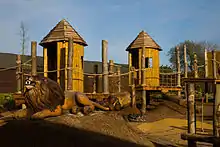
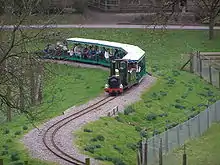
The Marwell Wildlife Railway (MWR), is a 15 in (381 mm) gauge railway operating around the front half of the zoo site. It is commonly known as Marwell Zoo Railway, although its locomotive is lettered MWR to reflect the formal name. The line runs for a little less than a kilometre, and is served by two stations, Treetops Junction and Park End Halt. The line opened in 1987[27] and still operates using the original rolling stock. It operates daily during school holidays, and at weekends for the rest of the spring, summer, and autumn. It is usually closed during the winter months.[28]
Rolling stock on the railway was supplied by Severn Lamb. The only locomotive is a 2-6-0DH steam-outline locomotive named Princess Anne.[29] There are four passenger coaches, each capable of seating 16 adult passengers. The coaches are roofed, but open-sided. There is a 4-wheel open wagon for maintenance trains.
References
- "Marwell Wildlife New Visitor Record Set". marwell.org.uk. Marwell Wildlife. Retrieved 11 December 2012.
- "BIAZA Find a Zoo". biaza.org.uk. British and Irish Association of Zoos and Aquariums. Retrieved 11 December 2012.
- "EAZA Member Zoos & Aquariums". eaza.net. European Association of Zoos and Aquaria. Archived from the original on 19 August 2010. Retrieved 11 December 2012.
- "Zoos and Aquariums of the World". waza.org. World Association of Zoos and Aquariums. Retrieved 11 December 2012.
- "Members Database". iucn.org. IUCN. Retrieved 11 December 2012.
- "Building Marwell zoo from scratch". BBC News. Retrieved 8 April 2018.
- Knowles, John (2009). My Marwellous Life: In Zoos and Conservation. Book Guild Publishing. ISBN 1-84624-365-3.
- "About Marwell Hall". marwell.org.uk. Marwell Wildlife. Archived from the original on 17 February 2013. Retrieved 11 December 2012.
- Page, William (1908). A History of the County of Hampshire: Volume 3. Victoria County History. pp. 332–335.
- "Owslebury". Hampshire County Council. Archived from the original on 24 June 2010. Retrieved 11 December 2012.
- "Wartime secrets of Marwell Hall". Retrieved 11 December 2012.
- "Marwell Hall Airfield". Archived from the original on 26 September 2011. Retrieved 11 December 2012.
- "South Today > Tell Tom > 1977 - Victor the giraffe". BBC. Retrieved 11 December 2012.
- Victor the giraffe. BBC. 6 October 2008. Retrieved 11 December 2012.
- "UK penguins struck by avian malaria". BBC News. 11 October 1999. Retrieved 11 December 2012.
- "Rare cub ventures into public eye". BBC News. 28 February 2008. Retrieved 12 December 2012.
- "You can call us Marwell Wildlife". Marwell Wildlife. Archived from the original on 6 November 2012. Retrieved 11 December 2012.
- "Marwell Wildlife Penguin Cove". marwell.org.uk. Marwell Wildlife. Archived from the original on 6 November 2012. Retrieved 11 December 2012.
- "Marwell Zoo". Marwell Zoo.
- "Marwell Wildlife Animal Inventory 2011" (PDF). marwell.org.uk. Marwell Wildlife. Retrieved 11 December 2012.
- "Marwell Wildlife Conservation". marwell.org.uk. Marwell Wildlife. Retrieved 11 December 2012.
- "Endangered Amur leopard born at zoo". 18 August 2014 – via www.bbc.co.uk.
- "Snow leopard cubs revealed at zoo". 17 July 2013 – via www.bbc.co.uk.
- "New arrival to send crowds wild at Marwell". Daily Echo.
- "Marwell Zoological Park". britishzoos.co.uk.
- "Marwell Hotel". www.marwellhotel.co.uk.
- See Marwell entry at Hampshire's Miniature And Narrow Gauge Railways.
- Marwell Wildlife Railway official website.
- Locomotive details at Miniature Railway World website.